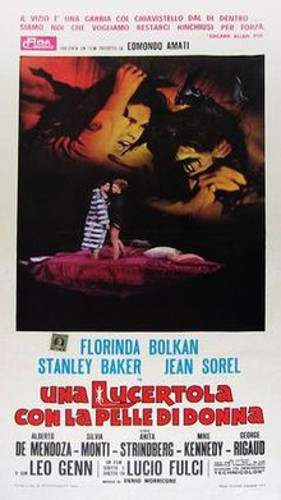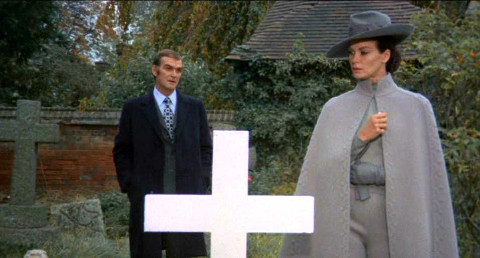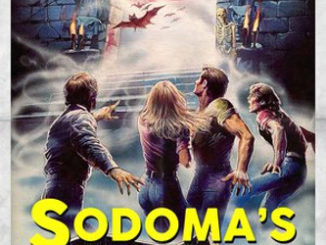A Lizard in a Woman's Skin (1971)
Directed by: Lucio Fulci
Written by: André Tranché, José Luis Martínez Mollá, Lucio Fulci, Roberto Gianviti
Starring: Florinda Bolkan, Jean Sorel, Silvia Monti, Stanley Baker
AKA UNA LUCERTOLA CON LA PELLE DI DONNA, SCHIZOID, CAROLE
Italy/France/Spain/UK
RUNNING TIME: 103 mins/102 mins/95 mins/93 mins
REVIEWED BY: Dr Lenera, Official HCF Critic
Carol Hammond is the daughter of a wealthy politician and is married to a rich lawyer. She would seem to have it made, but her husband Frank is cheating on her, while she keeps having weird dreams involving her neighbour Julia, whose swinging parties and decadent lifestyle both infuriate and excite her, and is visiting a psychiatrist as a result. During one of these dreams, Carol has a lesbian encounter with Julia which is witnessed by two hippies, and then stabs her to death. The following day Julia is found murdered. Did Carol do it, or did someone frame her?….
So as promised at the beginning of my review for Lucio Fulci’s Seven Black Notes, here’s my review for what I believe to be Fulci’s best giallo after the near-masterpiece that is Don’t Torture A Duckling, though Seven Black Notes comes pretty close to it while I have yet to see One On Top Of The Other and Murder Rock. But in any case A Lizard In A Woman’s Skin is a major entry in the wave of giallos inspired by the success of The Bird With The Crystal Plumage, partly because it’s very different to Dario Argento’s film and can’t at all be called a knock-off [though I do feel it influenced Argento’s much later The Stendahl Syndrome]. For a start there’s only one on-screen killing and far more emphasis is placed on the police procedural elements, plus the handling is genuinely hallucinatory in places yet the script still makes a reasonable amount of sense [though try to work out who sent the photographs – I can’t!] even if some of the sub-plotting, intended to distract the viewer so he or she doesn’t guess what’s going on too early, maybe feels a little forced. And, while Beatrice Cenzi contained a bit of graphic violence, I believe that A Lizard In A Woman’s Skin is the first film in which Fulci really showed his interest in extreme gore and shocking the viewer, something that he later developed a reputation for. I wouldn’t be surprised if there was a connection between this and the two tragic incidents that occurred not long before he made this film – the suicide of his wife and death of his daughter in a car crash – events that without a doubt played a large part of shaping the anger, fatalism and nihilism that filled many of Fulci’s subsequent films and showed his view of the world. Yet the grisly stuff certainly doesn’t dominate A Lizard In A Woman’s Skin which is interested as much in psychology and mystery, and would still probably work fairly well with the extreme material cut out.
It was Fulci and Roberto Gianviti who came up with the original story, though the actual script was also worked on by André Tranché. Somebody who had nothing to do with the screenplay was José Luis Martínez Mollá despite being listed in the credits. Because there was a lot of Spanish money in the film, the production had to both employ and credit some Spanish people even if they didn’t actually do anything. The Italian/French/Spanish/UK production was shot under the title of La Gaffia [The Trap]. Some interiors were filmed at Der Studios in Rome but all exterior work and even some interiors were shot at various London locations [and if you know London then you’ll notice that some of the geography in the film is decidedly iffy] and Wovan Abbey near Milton Keynes. Fulci wanted his lead actress to be blonde, but Florinda Bolkan refused to dye her hair and Fulci, who could be something of a bully but who respected those who stood up to him, let her have her way. In Italy, Fulci was threatened with a two year prison sentence because it was thought that real dogs were cut up on screen for real, and special effects man Carlo Rambaldi presented one of his prosthetic model dogs in four separate courts. Different countries often saw slightly different versions, with for example the Italian release losing some sexual material and the UK print having the dog scene, one other gory shot and a tiny dialogue scene removed while the US cut entitled Schizoid lost rather more dialogue but had slightly more sexual stuff. Even DVD releases differed and only a few months ago was a totally complete version put together and released.
The film opens with one of Carol’s dreams and it gets the film off to the most arresting start possible. Carol is making her way down a busy train and has to fight her way past some naked passengers having an orgy before falling through space and engaging in a pretty steamy lesbian sex scene with her neighbour Julia. Yes, the latter is just a bit of sexploitation but the whole sequence is beautifully shot, the way Carol’s coat ripples lingering especially in the mind. Carol’s psychiatrist Dr. Kerr [who in total breach of patient confidentiality records their conversations] thinks that it’s basically about her conflicting feelings about the free love hi-jinks that go on next door, and even after the next dream in which Carol kills her [the camera lingering on the bleeding wounds in true Fulci fashion] reckons that she’s just trying to fight off her attraction to this decadent lifestyle. But then Julia is found stabbed to death for real, and due to her dream is an obvious suspect. Evidence mounts more and more against her, though it’s possible that somebody with knowledge of her dreams could be trying to frame her. In the dream two hippies seemed to witness the act, so she and Joan, her husband Frank’s teenage daughter from a previous marriage, set out to find them – and when they do, the hippies don’t recognise Julia at all, though one of them soon attempts to kill her. And what’s all this blackmail stuff going on concurrently, beginning with when Julia’s politician father Edmund receives a phone call from an anonymous woman who claims that she has damaging information about his family? Is this “damaging information” the fact that Frank, who’s foremost in the long list of other suspects, is having an affair with his personal secretary Deborah? Inspector Corbin certainly has his work cut out for him and so do we.
For about three quarters, it’s all very good indeed even if things tend to slow down when the police discuss and attempt to solve the case despite the odd but nice touch of Corbin constantly whistling one of the film’s musical themes. Carol sometimes seems to hallucinate which results in some quite disturbing imagery including those afore-mentioned dogs – cut up but still breathing – which do indeed unpleasantly real even when seen today. And then there’s members of Carol’s family sitting around a table with distorted faces like in a Francis Bacon painting and one woman’s guts spilling out onto her lap. The image is so unsettling that even an unconvincing giant swan fails to really weaken things – in fact its strangeness can almost be said to add to it all. On the other hand a bat attack looks rather more realistic than the norm – compare it to similar moments in some Hammer films. Bolkan claims that real bats were used, though on the Blu-ray extras Rambaldi says it was models and even shows us one. I’m tempted to believe it was a bit of both. There are several excellently handled sequences set in the’ real’ world too, most notably a pursuit at Alexandra Palace that even goes in the catacombs and onto the roof. Fulci maintains nail-biting tension during this tremendous Hitchcock-style set piece here despite the scene’s great length. However, after that high point things do downhill a bit. Things come across as being rather rushed, while another murder plus a suicide disappointingly take place off screen, as if they ran out of money to shoot them And the film doesn’t end with a climax but a low key finale as Corbin works everything out. I’ve come to rather like it – it’s different, very effectively staged in a cemetery, and Stanley Baker’s acting is really rather excellent here – but some viewers may be disappointed.
The view of early 70’s Swinging London comes across as being rather conservative, though it does also show that Fulci has similar mixed views about what the likes of Julia get up to as does his heroine. I detected a similar attraction to/repulsion from unbridled sexuality in The New York Ripper. The carnal content in this film also includes a wild orgy scene, shot in a mass of odd angles, inter-cut and even shown in split-screen with calm dinner in the Hammond household. In fact cinematographer Luigi Kuveiller should really be held up as one of the main creators of the movie considering how much his work contributes to the off-kilter feel of the whole piece without really going overboard. Some modern viewers may not even notice the shaky hand held camerawork during some of the scenes involving Carol because such style of filming is very common today [where it’s often overdone to the point of making the viewer feel sick], but it wasn’t employed much in 1971. Even some of the simplest dialogue scenes contain odd match cuts, unusual positioning of characters in the frame, and the like. Things like a dissolve to Carol’s eye which shows two policemen reflected in it may not be much, but certainly the amount of care Fulci took with this film, just like Seven Black Notes.
Florinda Bolkan, who soon after bore the brunt of Fulci’s most powerful and upsetting scene ever in Don’t Torture A Duckling, is terrific here, though I guess if you’ve also seen her in Flavia The Heretic then this won’t surprise. She was definitely one of the best actresses appearing in these kinds of films around this time, and here she’s properly convincing yet still sympathetic as as a very disturbed woman [but I’m not going to tell you if she killed her neighbour or not], which is just as well considering the amount of close-ups she gets – though she’s a beauty too. The English dubbing is generally okay along with a decent number of English performers speaking their own language, though the Italian language track is interesting because it reveals more information about some of the characters. Ennio Morricone’s score is certainly in the upper echelon of his giallo work, with plenty of his odd kind of psychedelic rock, a beguiling main theme full of mystery and tension that makes great use of Edda Dal’ Orso’s wonderful voice, and a moving, yet still mysterious, theme for Carol. The second to last track actually seems to place one cue on top of another, creating some appropriate dissonance. Though sometimes awkwardly paced and structured, A Lizard In A Woman’s Skin is still memorably mysterious and unusual and is evidence that giallos certainly weren’t all the same despite what some like to say.
Rating: 

















Be the first to comment